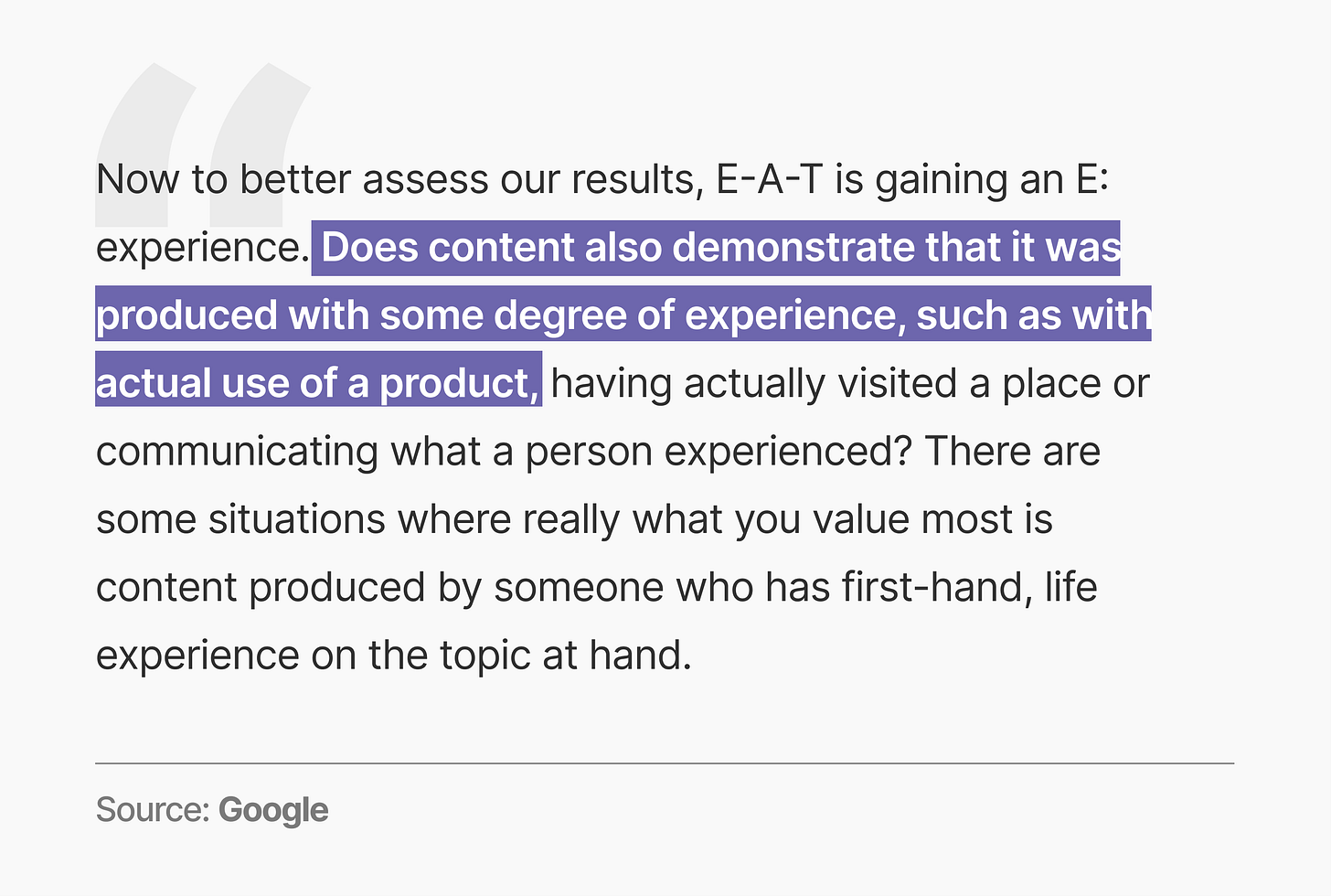Stories Before Traffic
Lessons from TechCrunch’s TC+ shutdown. And Rease Rios on how starting with stories and not obsessing over more traffic drove growth.
Jan 2024, TechCrunch made the news.
For the wrong reasons:
They laid off eight staff members.
And announced sunsetting TC+.
There have been a couple of explanations for this. ADWEEK’s Mark Stenberg reports that TechCrunch plans to “now lean more heavily into original reporting and content, as well as sponsored posts.” Danny Crichton, former senior author at the tech media giant, detailed how TechCrunch’s business model caused their woes. Expanding on Danny’s take, Jacob Donelly, Founder of A Media Reporter, succinctly captured the problem:
TechCrunch didn’t actually have an audience. It had a lot of traffic. If over 90% of your traffic is coming from Google Search and Google News, you are not a sustainable business. You operate at the whims of a platform, and incentives will force you to create content for that platform, which is basically what Crichton [went] on to explain.
Going by this, it’s safe to say that TechCrunch realized its flaw: They focused primarily on bumping their traffic numbers, not building an engaged audience of readers. The result was periodic bumps of passersby who turn to them to confirm the latest funding news or tech gossip. Not people who were really interested in TechCrunch as a brand. Could this be why they now want to “lean more heavily into original reporting and content…?”
I think so, and here’s why.
TechCrunch was likely generating generic traffic from random people who didn’t really care about their brand or the quality (not authenticity) of the content they published. I don’t know about you. But the times I’ve visited TechCrunch, it’s mostly to glance the link to funding news shared by the company executives who raised the fund via a LinkedIn post. TechCrunch is the last place that, if it ever does, come to mind when I want insightful tech business content written to be worth 10–15 mins of my time. Slapping a monthly subscription on such kind of content wasn’t ever going to fly.
A small percentage may subscribe to access the rest of a news-related info when it’s hot. One or two months later, the need for that is sure to diminish. As it does, so will they dash to cancel their TC+ subscription. Of course, TechCrunch hasn’t shared how its subscription business performed and why they’re sunsetting it. But if it was profitable, who would’ve done such?
Donelly, again:
Who you create content for matters. If you cannot clearly articulate [your] audience or you are investing resources in creating content simply because it “could drive 100,000 page views or more,” then you’re at risk.
The question for you is, how do you avoid such risk?
It’s easy. Create content that matters:
Start with stories people will want to read. Rethink your obsession with generating more traffic for the sake of it. Take a moment to articulate ‘who’ you’re creating content for (i.e., your ICPs). It matters. Prioritize telling stories that attracts those articulated ICPs and builds you an audience comprised mostly of them. All this is because a crucial, if not the most, leverage B2B businesses get from content is building audiences of raving fans. By raving fans, I mean engaged readers who actually want to read your next stuff. Occasionally, it’s okay to attract random searchers of info on a trending topic, if it relates to your business or the sector you operate it. Where it makes sense, it okay to optimize content for more organic search discovery.
What isn’t okay? Doing it solely for higher traffic numbers. Rephrasing Conelly: This forces you to create content at the whims of a platform. And the incentives (to rank higher and get more traffic) also forces you to create content for that platform (and not for people).
Rease Rios shared why this happens:
“[We] initially love getting traffic and seeing high numbers, but after a while, [we] question the value of that traffic. SEO is just a small part of a bigger picture that companies should pay attention to. Focusing too much on keywords and formatting at the expense of reader experience will ultimately lead to failure.”
Before joining Qase as Director of Content, Rease Rios was a Senior Content Manager at Webflow. You could sense genuine excitement in her voice as she shared how aiming to engage customers by sharing their stories above driving more traffic transformed Webflow’s Year-in-Review.
The first thing she stressed? As TechCrunch is now realizing, the need to rethink SEO and look beyond just bumping traffic numbers:
Webflow’s Year-in-Review was the typical employer branding initiative that primarily measured traffic to the page. Rease rethought this. Her new focus was to honor, share, and distribute stories of how people were using Webflow to achieve amazing things. To make this shift, Rease worked with the data team to identify the most popular community-created templates and websites from the entire year. She also researched various Webflow creators, and made sure the eventual campaign highlighted a diverse group of people to reflect Webflow’s global community.
More important, Rease took great care to ensure that every featured story and person was recognized and celebrated. They sent personalized emails on launch day to recipients, achieving a substantial, 50% increase in engagement during the first week compared to the previous year.
The transformation didn’t end there.
Collaborating with Webflow’s entire content team, Rease created a comprehensive dashboard that tracked various metrics. She tracked new sign-ups to Webflow, existing customers upgrades, and the number of people opening the Webflow designer. All these numbers increased significantly, all because they focused on stories that resonates with people, not just traffic:
I took lots of notes as Rease spoke.
And that’s because there’s was so much to learn. If I could share one of the many learnings I jotted from our conversation with the team at TechCrunch, as they look to put their woes behind them, it would be this one:
Ranking and traffic alone do not necessarily lead to new customers or increased revenue. It is crucial to look beyond mere statistics and focus on creating meaningful experiences that resonate with your audience.
Rease also detailed how she’s taking that same community and audience-building focus towards executing Qase’s content strategy. Specifically, she shared with me how having an online presence where the company’s target audience hangs out is a core of their content strategy execution.
I asked why do that, and she responded:
To understand what is needed (i.e., the stories to tell), you need to be where your target audience is. Spend time scrolling through forums to see what questions people are asking. Don't overlook the long-tail questions—they may hold the key to crafting engaging and informative content.
Hear it directly from her:
Rease Rios shared so much more…
You should👇
Crafted in VEC Studio
Why is finding good B2B writers hard?
According to Paul Graham, who said it most succinctly, because good business-to-business (B2B) SaaS writing is an outcome of…
Good thinking:
But here’s the thing.
All good writing, and not just business-to-business writing, requires good thinking. But specific to B2B, you don’t just want good thinkers. Look out for writers who also think broadly and long-term.
Chris Gillespie shared why:
Thinking broadly and long-term —weighing the interests of 5–7 people over a 6–12 month sales cycle— and contextually blending both into every written piece requires the left and right brain always working in tandem.
Why? Because creativity blended with logical reasoning is how good B2B content gets written:
To identify B2B writers who have this trait, look out for three things:
1. Unique Angles
Two changes have rocked the content world in recent years.
The first was Google’s 2022 Helpful Content Update. The second was the E-E-A-T (Experience, Expertise, Authoritative, and Trustworthy) Update in 2023. Use both as a yardstick for the type of content people —and search engines— now reward, and the need for B2B writers who can spin unique angles on topics they write about pops.
For instance, the first update rewards content having new insight (i.e., has a higher information gain score compared to similar ones on the same topic). This means Google is more likely to show target readers your written content, if said content has new information more likely to help them.
Here’s the logic used:
To write content with new insight, and earn a higher information gain score, a B2B writer needs an angle different from others. What better way to do that than by sharing their own experience(s)?
Google, and other search engines, must’ve known this. So in 2023, they announced the E-E-A-T Update. Before now, content written by or involving experts, authoritative and trusted persons did better. Taking it a step further, Google added ‘experience’ to the mix.
According to them:
The key phrase, as highlighted above, is, “does content also demonstrate?” This means, added to writing with new insight to gain higher information gain score, a B2B writer should also demonstrate how to use a product to solve a problem they are writing about.
To do that, they must use the product themselves.
So when evaluating writers, we:
Assign them a popular topic/keyword
Give them access to a B2B product that solves problem(s) related to the assigned topic/keyword
Pay them to write a 500-word draft on the assigned topic/keyword.
What do we look for here?
Those who can think deeply enough to spin a unique angle on the topic/keyword assigned to them, relative to how the product we gave them access to, solves a problem related to the topic/keyword. That’s crucial for growing with content written for your B2B SaaS.
Want to learn the other other two (2) crucial things to look out for when looking to land exceptional B2B SaaS writers?
It’s all in this free guide.
Thanks so much for reading.
Comments? Leav’em below👇
Enjoyed this one? 🙏🏻..
When you’re ready
Three ways we can help:
Chat with VEC Studio to design and execute a story-driven, product-led content [Product-Led Storytelling] strategy to grow your B2B SaaS.
Arm yourself (or team) with the frameworks for crafting story-driven, product-led content that earns mindshare and drives growth.
Convey ideas better and stand your marketing assets out with well-designed visuals. Our sister brand, Curt.studio, offers easy marketing design subscriptions you can tailor to your needs.












